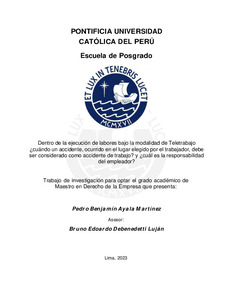| dc.contributor.advisor | Debenedetti Luján, Bruno Edoardo | |
| dc.contributor.author | Ayala Martínez, Pedro Benjamín | |
| dc.date.accessioned | 2023-12-07T21:08:42Z | |
| dc.date.available | 2023-12-07T21:08:42Z | |
| dc.date.created | 2023 | |
| dc.date.issued | 2023-12-07 | |
| dc.identifier.uri | http://hdl.handle.net/20.500.12404/26657 | |
| dc.description.abstract | La pandemia provocada por el COVID19 (en adelante cada vez que utilicemos el término pandemia, esto se refiere a COVID19), no sólo trajo cambios en la salud de las personas, en los usos y costumbres personales y familiares, así como en todas nuestras relaciones interpersonales sino que también trajo consigo un cambio en las relaciones laborales, concretamente el uso masivo de la figura del trabajo en remoto, es decir, desde casa, sobre todo al inicio de la pandemia para luego convertirse en lo que este año 2022 se llama Teletrabajo, que puede ser puro, es decir, sin asistiendo a las oficinas, o bajo la modalidad híbrida que combina días en oficina y días en casa o lugar elegido para trabajar.
Ahora bien, antes de la pandemia existía a nivel mundial la modalidad de trabajo realizado fuera de las instalaciones de la empresa, denominada Teletrabajo, tenemos que esta modalidad se implementó de manera abrupta a nivel mundial durante los años 2020 y 2021, años en los que se restringió la libertad de tránsito y para realizar funciones. en el lugar de trabajo estaban restringidos.
Bajo este escenario, las tareas administrativas, salvo algunos sectores que la normativa catalogó como esenciales -en el caso peruano Decreto Supremo 044-2020-PM, se realizaban desde el domicilio del trabajador o desde el lugar elegido por él como prevención al contagio. Sin embargo, no se tuvo en cuenta ni acotó si los accidentes que pudieran sufrir los trabajadores en el hogar o lugar de trabajo debían considerarse accidentes de trabajo; Asimismo, no se deslindó la responsabilidad del empleador.
A partir del escenario descrito en el párrafo anterior, este trabajo busca establecer una guía para operadores de justicia, inspectores de entidades fiscalizadoras y empleadores sobre cuándo un accidente ocurrido durante el Teletrabajo debe ser considerado un accidente de trabajo y en qué medida el cubre la responsabilidad de la empresa | es_ES |
| dc.description.abstract | The pandemic caused by COVID19 (hereinafter every time we use the term pandemic, this refers to COVID19), not only brought changes in people's health, in personal and family uses and customs, as well as in all our interpersonal relationships but also brought with it a change in labor relations, specifically the massive use of the figure of working remotely, that is, from home, especially at the beginning of the pandemic and then becoming what this year 2022 is called Teleworking, which can be pure, that is, without attending the offices, or under the hybrid modality that combines days in office and days at home or place chosen to work.
Now, before the pandemic, there was worldwide the modality of work carried out outside the company's facilities, called Telework, we have that this modality was implemented abruptly worldwide during the years 2020 and 2021, years in which the freedom of transit and to perform functions in the workplace were restricted.
Under this scenario, administrative tasks, except for some sectors that the regulations classified as essential – in the Peruvian case Supreme Decree 044-2020-PM, were carried out from the worker's home or from the place chosen by him as prevention to contagion. However, it was not taken into account or delimited as to whether accidents that workers might suffer at home or place of work should be considered as accidents at work; Likewise, the employer's liability was not delimited.
Based on the scenario described in the previous paragraph, this paper seeks to establish a guide for justice operators, inspectors of audit entities and employers regarding when an accident that occurred during Telework should be considered an accident at work and to the extent that the company's responsibility covers | es_ES |
| dc.language.iso | spa | es_ES |
| dc.publisher | Pontificia Universidad Católica del Perú | es_ES |
| dc.rights | info:eu-repo/semantics/openAccess | es_ES |
| dc.rights.uri | http://creativecommons.org/licenses/by-nd/2.5/pe/ | * |
| dc.subject | Pandemia de COVID-19, 2020- | es_ES |
| dc.subject | Teletrabajo--Legislación | es_ES |
| dc.subject | Trabajadores--Derechos--Perú | es_ES |
| dc.subject | Accidentes de trabajo--Legislación--Perú | es_ES |
| dc.title | Dentro de la ejecución de labores bajo la modalidad de Teletrabajo ¿cuándo un accidente, ocurrido en el lugar elegido por el trabajador, debe ser considerado como accidente de trabajo? y ¿cuál es la responsabilidad del empleador? | es_ES |
| dc.type | info:eu-repo/semantics/masterThesis | es_ES |
| thesis.degree.name | Maestro en Derecho de la Empresa | es_ES |
| thesis.degree.level | Maestría | es_ES |
| thesis.degree.grantor | Pontificia Universidad Católica del Perú. Escuela de Posgrado | es_ES |
| thesis.degree.discipline | Derecho de la Empresa | es_ES |
| renati.advisor.dni | 42741621 | |
| renati.advisor.orcid | https://orcid.org/0000-0002-3890-8917 | es_ES |
| renati.author.dni | 42071364 | |
| renati.discipline | 422317 | es_ES |
| renati.juror | Cueva Vieira, Aurelio Eduardo | es_ES |
| renati.juror | Mejia Mejia, Claudia Vanessa | es_ES |
| renati.level | https://purl.org/pe-repo/renati/level#maestro | es_ES |
| renati.type | https://purl.org/pe-repo/renati/type#trabajoDeInvestigacion | es_ES |
| dc.publisher.country | PE | es_ES |
| dc.subject.ocde | https://purl.org/pe-repo/ocde/ford#5.05.01 | es_ES |







